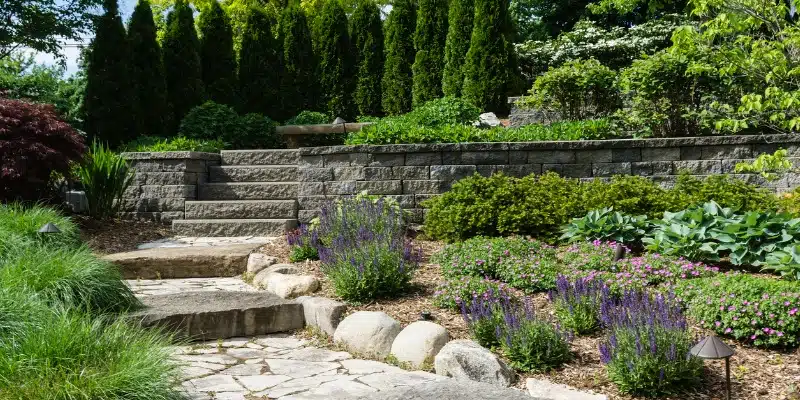Welcome to our guide on modern landscape design ideas for gardens. In today’s fast-paced world, gardens serve as havens of relaxation and rejuvenation, offering a sanctuary where we can reconnect with nature and escape the stresses of daily life. Modern landscape design ideas embraces innovation, sustainability, and functionality, allowing homeowners to create outdoor spaces that are not only beautiful but also practical and environmentally conscious.
In this comprehensive guide, we will explore ten inspiring Modern landscape design ideas that will transform your garden into a modern masterpiece. From minimalist Zen gardens to futuristic oasis, each design concept offers unique opportunities for creativity and expression. Whether you’re a seasoned gardener looking to refresh your outdoor space or a novice enthusiast embarking on your first landscaping project, you’ll find plenty of inspiration and practical tips to help you bring your vision to life.
1. Minimalist Zen Garden
- Description: Create a serene retreat with a minimalist Zen garden featuring clean lines, gravel or sand raked into patterns, and strategically placed rocks or boulders. Incorporate elements such as bamboo, Japanese maples, and stone lanterns for an authentic Zen aesthetic.
- Key Features: Zen gardens focus on simplicity, balance, and tranquility. Use neutral colors, sparse plantings, and natural materials to create a calming atmosphere.

2. Sustainable Garden Design
- Description: Embrace eco-friendly practices by designing a sustainable garden that conserves water, promotes biodiversity, and minimizes waste. Incorporate native plants, rainwater harvesting systems, compost bins, and permeable paving materials to reduce environmental impact.
- Key Features: Sustainable gardens prioritize environmental stewardship and resource conservation. Choose drought-tolerant plants, organic fertilizers, and natural pest control methods to create a resilient and eco-conscious landscape.

3. Vertical Garden Wall
- Description: Maximize space and add visual interest to your garden with a vertical garden wall. Install modular planters, trellises, or living walls to create a lush vertical garden filled with cascading foliage, flowering vines, and herbs.
- Key Features: Vertical gardens offer a creative solution for small or urban spaces, allowing you to grow plants vertically on walls, fences, or structures. Choose a variety of plants with different textures, colors, and growth habits to create a dynamic and eye-catching display.

4. Contemporary Water Feature
- Description: Add a touch of elegance and tranquility to your garden with a contemporary water feature such as a sleek fountain, reflecting pool, or cascading waterfall. Incorporate clean lines, geometric shapes, and modern materials like stainless steel, glass, or concrete for a sophisticated look.
- Key Features: Water features create a focal point in the garden while providing soothing sights and sounds. Choose a design that complements your overall aesthetic and enhances the ambiance of your outdoor space.
5. Outdoor Entertaining Area
- Description: Design a stylish and functional outdoor entertaining area where you can relax, dine, and entertain guests in style. Create separate zones for lounging, dining, and cooking, and incorporate features such as built-in seating, fire pits, outdoor kitchens, and dining pavilions.
- Key Features: Outdoor entertaining areas extend your living space into the garden, providing a comfortable and inviting environment for socializing and relaxation. Choose durable and weather-resistant materials for furniture, flooring, and accessories to ensure longevity and easy maintenance.
6. Edible Landscape Design
- Description: Combine beauty and functionality with an edible landscape design featuring a diverse array of fruits, vegetables, herbs, and edible flowers. Integrate edible plants into ornamental beds, borders, and containers, creating a lush and productive garden that nourishes both body and soul.
- Key Features: Edible landscapes blur the lines between traditional vegetable gardens and ornamental landscapes, offering a sustainable and rewarding approach to gardening. Choose a mix of edible plants that thrive in your climate and provide beauty, flavor, and nutrition throughout the year.
7. Sculptural Garden Elements
- Description: Add visual interest and artistic flair to your garden with sculptural elements such as modern sculptures, abstract art installations, and architectural features. Use bold shapes, textures, and materials to create striking focal points that enhance the overall design.
- Key Features: Sculptural garden elements serve as conversation starters and focal points, adding personality and drama to outdoor spaces. Choose pieces that reflect your personal style and create visual impact without overwhelming the landscape.
8. Smart Garden Technology
- Description: Embrace the latest technology and innovation with a smart garden featuring automated irrigation systems, LED lighting, weather sensors, and smartphone-controlled devices. Use smart technology to optimize water usage, enhance plant growth, and monitor environmental conditions in real-time.
- Key Features: Smart garden technology allows you to remotely control and monitor your garden, saving time, water, and energy while maximizing plant health and productivity. Choose devices and systems that are compatible with your existing infrastructure and provide easy integration and operation.
9. Native Plant Habitat Garden
- Description: Create a haven for native wildlife and pollinators with a native plant habitat garden featuring a diverse array of indigenous plants, shrubs, and trees. Design your garden to mimic natural habitats, incorporating layers of vegetation, water features, and nesting sites for birds, bees, butterflies, and other wildlife.
- Key Features: Native plant habitat gardens support biodiversity and ecological balance while providing food, shelter, and habitat for native species. Choose plants that are adapted to your local climate, soil, and growing conditions, and avoid invasive species that may outcompete or disrupt native ecosystems.
10. Futuristic Garden Oasis
- Description: Design a futuristic garden oasis inspired by science fiction and cutting-edge technology. Incorporate sleek, high-tech materials, futuristic lighting, and innovative features such as solar panels, hydroponic gardens, and vertical farming systems.
- Key Features: Futuristic gardens push the boundaries of traditional landscape design, incorporating advanced technologies and sustainable practices to create immersive and awe-inspiring outdoor spaces. Choose futuristic elements that reflect your vision for the future and create a sense of wonder and possibility.
FAQ of Modern Landscape Design Ideas
How do I maintain my modern landscape garden?
To maintain a modern landscape garden, regular upkeep is essential. This includes tasks such as watering plants as needed, pruning trees and shrubs to maintain their shape, removing weeds, fertilizing as necessary, and cleaning any outdoor features or furniture. Additionally, monitoring the health of your plants and addressing any issues promptly will help keep your garden looking its best.
What are the benefits of incorporating sustainable practices into my garden design?
Incorporating sustainable practices into your garden design offers numerous benefits, both for the environment and for your own well-being. Sustainable gardening helps conserve water, reduce chemical use, promote biodiversity, and create healthy, resilient ecosystems. It also encourages a deeper connection with nature and fosters a sense of stewardship for the planet.
How can I attract wildlife to my garden?
To attract wildlife to your garden, consider incorporating features that provide food, water, shelter, and nesting sites for birds, bees, butterflies, and other creatures. Planting native flowers, shrubs, and trees that produce nectar, pollen, and berries will attract pollinators and birds. Additionally, providing sources of water such as bird baths or shallow ponds, creating habitat areas with dense vegetation or brush piles, and avoiding the use of pesticides will help support a diverse array of wildlife in your garden.
What types of plants are suitable for a low-maintenance garden?
Several types of plants are well-suited for low-maintenance gardens, including native species adapted to your local climate and growing conditions, drought-tolerant plants that require minimal watering once established, and perennial plants that return year after year without needing replanting. Succulents, ornamental grasses, and groundcovers are also excellent choices for low-maintenance landscaping.
How can I incorporate technology into my garden design?
There are many ways to incorporate technology into your garden design, from automated irrigation systems and smart lighting controls to weather monitoring devices and soil sensors. These technologies can help you conserve water, optimize plant growth, and enhance the overall functionality and enjoyment of your outdoor space. Additionally, incorporating solar panels or other renewable energy sources can help power your garden features while reducing your carbon footprint.
What are some design tips for creating a cohesive and harmonious modern landscape?
When designing a modern landscape, consider elements such as symmetry, balance, repetition, and contrast to create a cohesive and harmonious look. Choose a limited color palette and select plants, materials, and features that complement each other and work together to create a unified aesthetic. Pay attention to scale and proportion, and use focal points such as sculptures, water features, or specimen plants to draw the eye and create visual interest.













